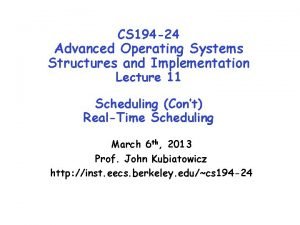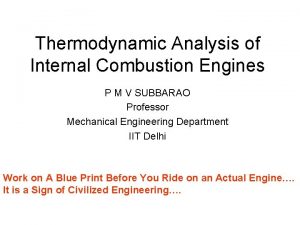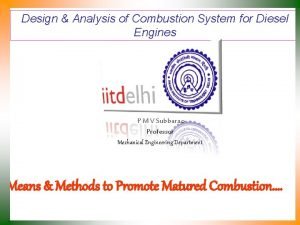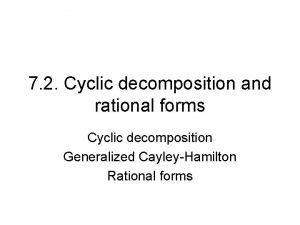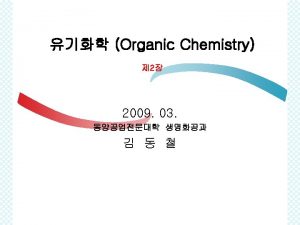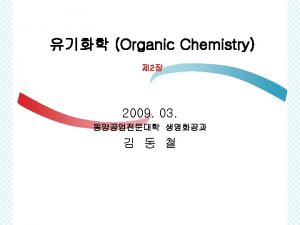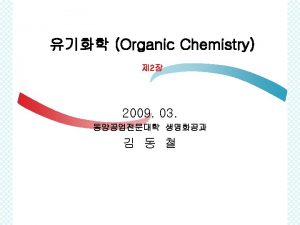Cyclic Analysis of Savery Engine and its Successors














- Slides: 14

Cyclic Analysis of Savery Engine and its Successors P M V Subbarao Professor Mechanical Engineering Department Analysis of Process & Event to be Executed by A PGS

Processes & Variables Oserved by Savery in His Engine

Cyclic Process in Savery Engine Starting Point: Time Events Process

Recognitions for savery’s Engine • Thomas savery demonstrated it to the Royal Society on 14 June 1699. • Savery described the machine in his book The Miner's Friend; or, An Engine to Raise Water by Fire in 1702. • In this book, he claimed that it could pump water out of mines. • A newspaper in March 1702 announced that Savery's engines were ready for use and might be seen on Wednesday and Saturday afternoons at his workhouse in Salisbury Court, London, over against the Old Playhouse.

Performance & Applications of Savery Engine • One of the savery engines was set up at York Buildings in London. • Another was built to control the water supply at Hampton Court. • The third at Campden House in Kensington operated for 18 years. • A few Savery engines were tried in mines failed to a satisfactory job.

Ability to Perform A True Thermodynamic Cycle Coal (Resource) The power (Need) Wastage / Ecological Nuisance

Drawbacks of Savery Engine: Critcism • Savery Engine was identified with four serious problems. • Firstly, the water first stage of the cycle required high-pressure steam to force the water up. • Secondly, every time water was admitted to the working vessel much of the heat wasted in warming up the water that was being pumped. • Much of the steam was condensed due to direct contact between water-steam and heating up of cylinder walls. • Thirdly, to clear water from a deep mine would have needed a series of moderate-pressure engines all the way from the bottom level to the surface. • Fourthly, water was pushed up into the engine only by atmospheric pressure.

Thomas Newcomen • Thomas Newcomen established himself as an ironmonger in his home town. • Some of his biggest customers were Cornish tin mine owners, who faced considerable difficulties with flooding as mines became progressively deeper. • The standard methods to remove the water - manual pumping or teams of horses hauling buckets on a rope - were slow and expensive, and they sought an alternative. Savery replaced mechanical vacuum with steam condensed vacuum

Reciprocating Pumps: Mechanical Vacuum Single Acting Pump Double Acting Pump

Cycle Executed by Pump: Indicator Diagram

Newcomen Engine : First Step in Innovation thru Conservation • Newcomen created his vacuum inside a cylinder and used it to pull down a piston. • It was the first practical engine to use a piston in a cylinder. • He then used a lever to transfer the force to the pump shaft that went down the mine. • Casting the cylinders and getting the pistons to fit was pushing the limit of existing technology. • Newcomen deliberately made the piston marginally smaller than the cylinder and sealed the gap with a ring of wet leather or rope. • To avoid infringing Savery's patent Newcomen was forced to go into partnership with him.

Thomas Necomen The original Thomas Newcomen engine was invented in 1712.

Anatomy of Newcomen Engine

Process & Cycle Executed by Newcomen Engine
 The arab empire and its successors 6-2
The arab empire and its successors 6-2 External and internal combustion engine
External and internal combustion engine The emigree poem
The emigree poem Its halloween its halloween the moon is full and bright
Its halloween its halloween the moon is full and bright Cyclic coordinates and conservation theorems
Cyclic coordinates and conservation theorems Conservation theorem and symmetry properties
Conservation theorem and symmetry properties Difference between right and left bronchus
Difference between right and left bronchus Cyclic executive scheduling
Cyclic executive scheduling Cyclic executive and bin packing
Cyclic executive and bin packing When a train increases its velocity, its momentum
When a train increases its velocity, its momentum Windy snowy rainy sunny
Windy snowy rainy sunny If its square its a sonnet
If its square its a sonnet Its not easy but its worth it
Its not easy but its worth it Internal combustion engine cycle analysis
Internal combustion engine cycle analysis Combustion analysis in engine design
Combustion analysis in engine design








